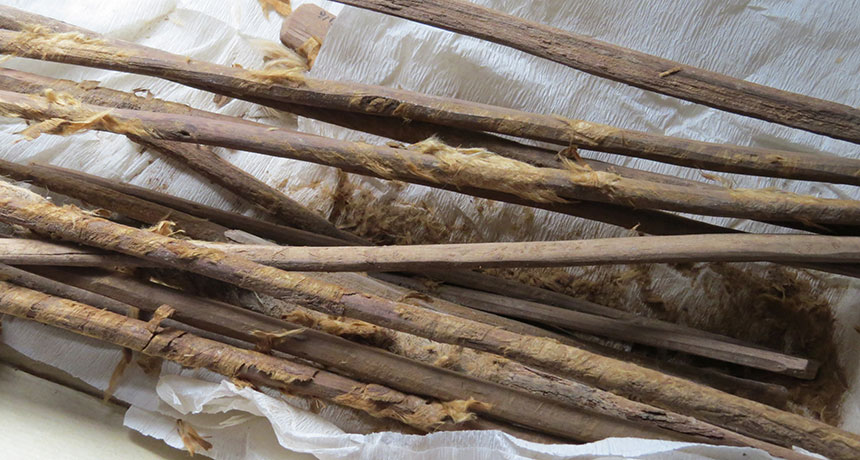Parasitic worm eggs found on Silk Road latrine artifacts

Rare evidence has emerged that humanborne infectious diseases moved across Asia around 2,000 years ago via the famous Silk Road. Clues to this ancient illness spread come from cloth wrapped around the ends of sticks once used by travelers as the equivalent of toilet paper.
Preserved feces on cloth caps of sticks previously excavated from a latrine at a Silk Road way station in north central China contain microscopic eggs of intestinal worms, including a species found only far to China’s south and east. A traveler or government official must have carried the infectious parasite to the desert-bordering pit stop from at least 1,500 kilometers away, says a team led by archaeologists Hui-Yuan Yeh and Piers Mitchell of the University of Cambridge. The scientists report their findings online July 22 in the Journal of Archaeological Science: Reports.
Yeh and Mitchell’s group shows for the first time that an infectious disease “must have been transported in the bodies of actual travelers on the Silk Road,” says linguist and China authority Victor Mair of the University of Pennsylvania.
The Silk Road consisted of a network of thoroughfares connecting eastern China to Central Asia, the Middle East and Europe (SN: 2/27/10, p. 14). Merchants, pilgrims, monks, soldiers and nomads traveled these routes. Historical documents suggest that the Xuanquanzhi relay station, where the cloth-capped latrine sticks were excavated, was built by China’s Han Dynasty 2,127 years ago (in 111 B.C.) and used for nearly 200 years. The location of the sticks in excavated sediment layers indicates they date to that time period. The Silk Road remained a key trade and travel route for roughly another 2,000 years.
Scholars have long suspected that Silk Road travelers spread infectious diseases such as bubonic plague and leprosy. But they have lacked biological evidence of such transmission.
The Xuanquanzhi latrine, located in the town of Dunhuang, dates to the Silk Road’s earliest period of use, Mitchell says. “Even at that early date, travelers were making huge journeys along its length,” he says. (Marco Polo made the best-known Silk Road trek, but in the late 1200s, long after Xuanquanzhi’s heyday.)
Yeh and her colleagues studied a combined fecal sample collected from cloth covers on six latrine sticks, as well as a larger fecal sample from a seventh stick cover.
A high-powered microscope revealed eggs of four species of parasitic intestinal worms: whipworm, roundworm, tapeworm and, on the sample from the seventh stick, Chinese liver fluke.
The first three types of worms provide insight into hygiene and food practices in ancient China. Today, whipworm and roundworm infect people throughout the world via contamination of food and hands by human feces. In ancient Asia, people probably came into contact with the worms while handling human feces used as a crop fertilizer, the researchers say. Tapeworm found at Xuanquanzhi probably spread throughout the continent when people ate raw or undercooked meat, such as pork or beef, the researchers suspect.
The Chinese liver fluke tells a different story. Causing stomach pain, diarrhea, jaundice and liver cancer, the parasitic flatworm lives in marshy, humid parts of East Asia, including eastern and southern China. These flatworms grow inside water snails before departing to live inside freshwater fish. Humans get infected by eating raw fish.
Xuanquanzhi is situated at least 1,500 kilometers from any region where the Chinese liver fluke exists today, the researchers say. Most cases of Chinese liver fluke infection now occur about 2,000 kilometers south of the Silk Road site, they add.
Han government officials established Xuanquanzhi as a military garrison and way station at what was the starting point of the Silk Road in Han times, says historian and Silk Road specialist Xinru Liu of the College of New Jersey in Ewing. Soldiers from various parts of China traveled to Dunhuang to man the garrison, some possibly carrying Chinese liver fluke, Liu suggests.